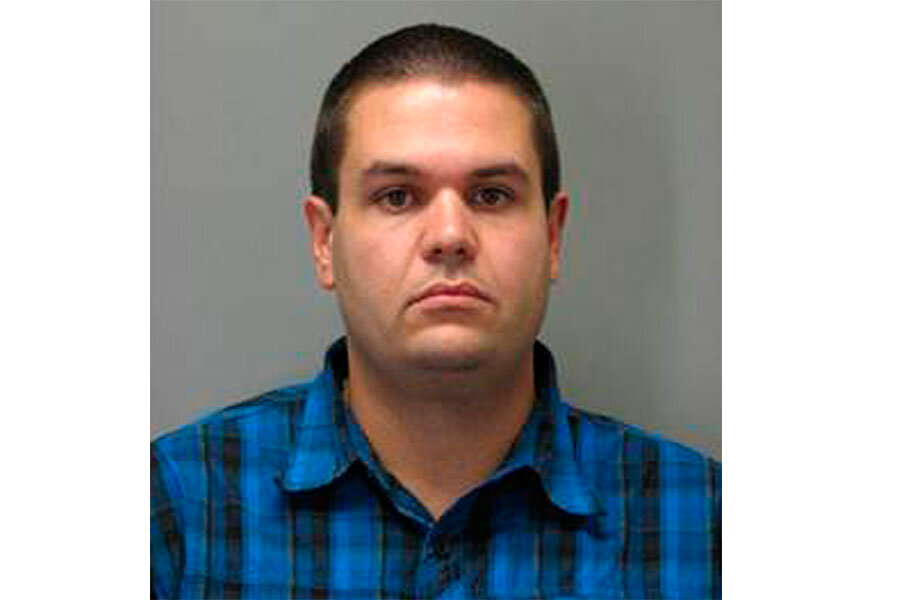Virginia cop's arrest reveals larger cracks in 'blue wall of silence'
Loading...
It took six days for the Ferguson Police Department to name then-Officer Darren Wilson as the man who fatally shot Michael Brown last Aug. 9. It took the police department in Virginia’s Fairfax County more than a year and a half to name the officer that shot and killed an unarmed man who others say had his hands up on his own doorstep.
Nearly two years after the Aug. 29, 2013, death of John Geer during a tense standoff at his home in Springfield, Va., a special grand jury on Monday indicted Adam Torres on a second-degree murder charge. The indictment and Mr. Torres’s subsequent arrest point to post-Ferguson cracks in the “blue wall of silence” at some police departments nationwide.
The Torres case gained national attention, with Sen. Charles Grassley (R) of Iowa, chairman of the Judiciary Committee, writing Fairfax Police Chief Edwin Roessler Jr. to demand a full accounting of the internal investigation. Senator Grassley reminded the chief that “questions about the use of deadly force should be handled in a manner that reinforces public confidence in law enforcement.”
The movement in the Torres case follows a series of more recent cases from Portsmouth, Va., to Los Angeles in which police leaders, realizing that lack of public trust in police ultimately puts officers at risk, have favored transparency over political expediency or concerns about officer morale. Gallup recently found that public trust of police is at a 22-year-low.
“Many police chiefs are now reacting [by offering transparency] when it comes to procedures after a police shooting,” says Laurie Robinson, a law professor at George Mason University in Fairfax and co-chair of the President's Task Force on 21st Century Policing. “Part of it is self-protection, but it’s also from a professional standpoint, to ensure that the community finds any investigation a credible one.”
Among the recent high-profile cases:
- In Los Angeles in May, civil rights activists commended Police Chief Charlie Beck after he publicly said he was “concerned” about the fatal police shooting of an unarmed homeless man that month.
- In Portsmouth, Va., the police chief this spring quickly brought in an outside agency to investigate two officer-involved shootings, citing new national guidelines on police accountability and transparency.
- After a university police officer in Cincinnati was accused of killing an unarmed motorist last month, a grand jury was quickly convened. In those proceedings, two other responding officers contradicted their colleague’s contention that he fired because he feared for his life. The now-fired officer, Ray Tensing, faces a murder charge in the death of Samuel DuBose.
- This month in Arlington, Texas, police moved quickly to fire an officer-in-training named Brad Miller for breaking safety protocol. He is accused of killing Christian Taylor, an unarmed teen who was ransacking a car dealership.
- On Tuesday, a judge in Albuquerque, N.M., found enough probable cause in the 2014 shooting death of a homeless camper to schedule a murder trial for Officer Dominique Perez and now-retired Officer Keith Sandy. Albuquerque police have killed 40 people in the past five years, and the US Department of Justice found last year that callous disregard for life had become part of a "pattern or practice" in the department. The shooting in question helped lead to an overhaul of Albuquerque's use of force policy.
In Fairfax, it took a judge to force the disclosure of information. In April, Fairfax County agreed to pay Geer's family nearly $3 million to settle a wrongful-death lawsuit. On July 31, Torres was fired.
His arrest this week marks the first time in the 75-year history of the Fairfax County Police Department that an officer has faced criminal prosecution in connection with an on-duty shooting.
“The irony is that it’s often the police departments that are the most resistant to making their actions more transparent that are the very police departments that tend to need the transparency more than anybody else,” says Rob Kane, a criminologist at Drexel University in Philadelphia.
The scrutiny of the past year has proven demoralizing for many of the nation’s nearly 400,000 police officers, police organization heads say. And unit morale is important for officers to do what Bill Johnson of the National Association of Police Organizations calls a “corrosive job.”
Nevertheless, many United States police chiefs are moving ahead with White House recommendations on policing.
Los Angeles is one of a growing number of police departments that have reformed their post-officer-shooting protocol, specifically by immediately separating the shooter from his colleagues on the scene. Meanwhile, body cameras – which data show can have a soothing effect on police interactions and protect citizens and police alike – are becoming ubiquitous.
The Fairfax case saw officers testify against Torres, something that has long been seen as a betrayal within the policing community.
While Torres said Geer’s arm moved toward his waist, others on the scene, including four officers, testified that Torres and the original police report got the facts wrong.
“When the shot happened, [Geer’s] hands were up,” one officer told investigators. “I'm not here to throw [Torres] under the bus or anything like that, but I didn't see what he saw.”
Signs are mounting that even rank-and-file officers have begun, at least to an extent, to question some long-held practices.
“Internal affairs or professional ethics and integrity divisions must do the job and call it as it happened,” writes ThinBlueLineVirignia, a self-described retired law enforcement officer on The Washington Post comment section. “Delays, cover-ups and [erecting a blue wall of silence] is not the way.”








